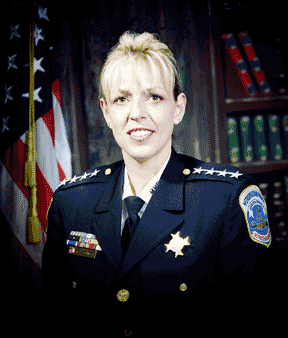|
||||||||
Cathy Lanier’s Long Climb
From high school dropout and single mom to chief of police in our nation’s capital.by Margaret TearmanAs D.C. Mayor Adrian Fenty’s surprise choice to replace Charles Ramsey as our capital city’s chief of police, leading a diverse police force of 3,800 officers, Harwood resident Cathy Lanier is most certainly an unlikely candidate. She’s female. She’s Caucasian. And, at 39, she’s relatively young. This historic appointment came without preamble, shocking everyone, including Lanier. “When Fenty told me he wanted me as his chief, I was completely surprised,” Lanier says. “I had no warning, no hints I was being considered.” Chapter I: FameLanier, a tall, charismatic blonde, is a reluctant celebrity. Since then-Mayor-elect Fenty’s surprise announcement on November 20, 2006, Lanier’s office has fielded requests for more than 250 interviews from media outlets coast to coast, including the CBS Evening News with Katie Couric and the Los Angeles Times. Once just another cop, today she’s recognized by District children approaching her on the street, some shyly asking for an autograph. Lanier has captured the imagination of a country looking for something to celebrate, reveling in the story of a woman who has apparently made it in spite of early obstacles on the road to the top. From her teen years, Lanier has defied the odds, and the story of her life — so far — is inspirational. Chapter II: Her Way In Lanier was raised in Tuxedo, Maryland, just off of Route 50. Her parents divorced when she was a child, and her mother Helen struggled as a single parent to raise Lanier and her two brothers. Lanier’s father, who passed away in 1982, was deputy chief of Prince Georges Fire Department. In spite of their father’s absence from their daily lives, his sons followed in his career footsteps and entered public service: One of Lanier’s brothers is captain of the Prince Georges Fire Department; the other is a Greenbelt police detective. Lanier wasn’t in step with the rest of her family. Instead, the young girl dreamed of being a lawyer; the only appointment she had in her sights was to the bench. Real life intervened, and Lanier didn’t even make it out of high school. While still in the ninth grade, Lanier got pregnant and dropped out of school to have her baby. She married the baby’s father at age 15, but the marriage lasted just two years. A 17-year-old single mother, Lanier worked as a secretary by day and as a waitress at night. She earned her GED and signed up at Prince Georges Community College, whenever she could afford the tuition, taking classes toward what she hoped would be an eventual law degree. When she was 23, Lanier learned about the tuition reimbursement program offered by D.C.’s Metropolitan Police Department. Determined to get the education she was unable to afford, Lanier made what would become a life-altering decision and entered the police academy. “I had to take a pay cut,” Lanier says. “I was making some pretty good money working those two jobs.” Once in the academy, Lanier said she knew “this was the job for me.” Law school was forgotten. Chapter III: A Record of FirstsWhen police departments began accepting women into the force, female officers were given limited, however important, assignments, usually administrative duties. It wasn’t until the early 1970s that policewomen were allowed to go on uniformed patrol. But it was still a man’s world, and the most visible evidence was the uniform. They are made for a man and don’t fit a woman’s body. “This is a huge complaint I still have,” Lanier says. “I’m working to quickly solve this problem, not just for me but for all the female officers on our force.” Today, approximately 25 percent of D.C.’s police department is female.
“The District’s police department has one of the best ratios of women out of big city forces,” Lanier says. Early in her law-enforcement career, Lanier had few female mentors, but when she earned the rank of lieutenant, then-assistant chief Sonya Proctor, the highest ranking woman she knew on the force, provided guidance and insight. Lanier found herself quickly climbing up the law enforcement ladder. She served as commander of the Fourth District, one of the largest and most diverse residential patrol districts. From there, she moved on to serve as commanding officer of the department’s Major Narcotics and Vehicular Homicide units. Lanier’s next rung on the ladder was first female commander of the Special Operations division, which includes highly trained SWAT and bomb units. During her four years there, she established the agency’s first Homeland Security Counter Terrorism branch and created an agency-wide response unit. In 2006, Lanier was named commanding officer of the department’s first Office of Homeland Security and Counter-Terrorism. All the time she continued her education, earning bachelor and master’s degrees in management from Johns Hopkins University and a master’s degree in national security studies from the Naval Postgraduate School. A pretty accomplished resume for a woman who dropped out of high school as a teenaged mother. How was she was able to manage? “Endurance,” she told Bay Weekly. “I just loved school. It made me a better person and made me better at my job.” Chapter IV: Stepping Outside the Old Boy NetworkIn spite of her accomplishments as an officer, Lanier was a female in a male-dominated force. Sexual harassment was real. When she first came on the force in 1990, she says, she faced unrelenting harassment from male officers. In an interview on WTOP radio, Lanier describes some of the incidents as “terrifying.” A rookie, she often worked the night shift. “A couple of times,” she said on radio, “I got shut in a sergeant’s office late at night and literally had to make threats to get out of the office.” At first she didn’t report the incidents. Finally, fed up with the behavior of one of her male lieutenants, she filed a formal complaint. “I followed department policies and procedures,” Lanier says, “but the system failed me.” Through a series of loopholes, the accused lieutenant was not even reprimanded. Now fearful of losing her job, she hired a lawyer and filed a civil suit. “Once I filed the suit, women came out of the woodwork to say they too were victims,” Lanier says. “A couple of male officers did the same, saying this lieutenant harassed their girlfriends or female partners.” She won the lawsuit and “split $75,000 with another female officer and their lawyers,” she told WTOP. The lieutenant was demoted to sergeant and eventually was fired for two other complaints against him. “Winning the lawsuit was very satisfying,” Lanier says. “It was never about the money. It was to protect our jobs.” As chief, Lanier vows not to tolerate harassment on the force. “Sexual harassment is not the pervasive problem it was 10 to 14 years ago,” she says. “But it’s still around. It’s misconduct, and it won’t be tolerated. It doesn’t belong in any workplace, especially not in a police department.” Chapter V: Hometown CelebrityThe 16-year veteran, once confirmed, will be the youngest chief and first woman to hold the title of chief on a permanent basis. (Sonya Proctor was interim chief before Ramsey was installed.)
“There has never been a woman chief,” Lanier said. “I never gave it the slightest thought.” She was thrilled but didn’t accept the appointment immediately. “It’s a big commitment, I don’t take it lightly,” she explained. “I wanted to be certain of my ability to do the job. If I had any reservations, I would not have accepted it.” When Fenty announced Lanier as his choice, nobody imagined the media frenzy that would follow. “I still can’t believe the interest,” Lanier said. “We all thought it’d be over in a week.” With the continued press onslaught, Lanier is now restricting interviews so, she says, “I can get some work done. I can’t sit behind a desk all day answering reporters’ questions.” Lanier now asks journalists to “follow me around when I’m in the field.” For this interview, we spoke by cell phone, at 8pm, as she was making the long commute back to Harwood. With all this media attention, Lanier has become a local celebrity. “I’m not recognized at home as much as in D.C. because I’m usually out of uniform,” Lanier says. “But just the other day I was getting gas and the 17-year-old kid behind the counter recognized me.” Lanier was impressed, not because she was recognized, but because the teenager “obviously reads a newspaper to know who I was.” Her new position will require Lanier to take up residence in the District. She is looking to purchase a townhouse there, but she will not give up her Harwood home. “I bought this house as my retirement home,” Lanier said, “and as a home for my son and for my mother, Helen, who is partially disabled.” Her mother will continue to live in the house, while her son, a recent college graduate, is making plans to move into a place of his own. “My son has no interest in a career in law enforcement,” Lanier said. “I’m very happy he’s moving on, moving out. I’m ready for an empty nest.” Chapter VI: Cops and Dogs
The Harwood house is important to Lanier for another reason: It is home to her five dogs. Lanier has two passions in life: police work and dogs. Especially the “discard dogs,” as she calls those with physical impairments. “These are dogs that would otherwise be put to sleep for no reason,” Lanier says. “They are all happy and friendly dogs.” Her pack includes three discards; Special Ed is blind and deaf. Stevie No Eyes Wonder, Lanier explains “can see movement and light and is partially deaf, so when you call him he goes the wrong way.” Misfit suffers a seizure disorder. The other two dogs, Justice and Outlaw, are “normal.” Lanier’s love of dogs spills over into her work. While commander of a new response team — the Special Threat Action Team created in response to the 9/11 terrorist attacks — Lanier suggested using a “discard dog” as stress therapy for officers undergoing the team’s difficult training regime. Patch, a deaf sibling of one of Lanier’s dogs (and living in Calvert with another D.C. police officer) was called to duty. After each officer completed a round of training, usually encased in an uncomfortable and confining protective suit, they were offered wind-down time with Patch. It was successful therapy for both officer and dog: the stressed officers were calmed and the physically impaired dog got socialization. As chief, Lanier hopes to start a program to match troubled youth in the community with rescued dogs to train for service work. “Once selected, the animals would be placed with kids in a detention center to train for later work with service dog organizations,” Lanier explains. “I think this would be a win all around. Incarcerated children will be engaged in training and caring for animals that would later be used to help blind or disabled in the community. This will teach the kids compassion and keep them away from other things while incarcerated — like learning new criminal skills. And it will help rescue throw-away animals that still have something to offer our society.” Chapter VII: Future UnknownCathy Lanier has come a long way, beating the odds and achieving professional and financial success. She’s climbed from high school dropout to a single mother working two jobs to the esteemed position of chief of police in our nation’s capital. As Lanier awaits her confirmation hearing, expected some time in February, she hardly has time to think about the future. All she knows, for now, is that when her tenure as chief of police in D.C. ends, she has no plans to move on to another big city police department. “I can’t imagine wanting to go anywhere else,” Lanier said. “Once my job here is done, the only thing I want to do is to start a rescue ranch for dogs.” Here? Who knows? The only thing Cathy Lanier can say for certain is that you never know what the future holds. This is contributor Margaret Tearman’s second Bay Weekly story on women leading police forces. The Calvert County documentary filmmaker’s first was ‘U.S. Park Police Chief Teresa Chambers Fights City Hall’ (Vol. xiii, No 14: April 7, 2005).
|
||||||||
|
|
||||||||
|
© COPYRIGHT 2004 by New Bay Enterprises, Inc. All rights reserved.
|







